A regular spot from team member Lynn Davy, a self-confessed bead addict whose unusual designs often feature lampwork beads. In this series she shares some of her secrets and shows you how to use FHFteam’s handmade beads and components in your own creations!
April 2012
Cabochons; or, What do I do with this, it hasn’t got a hole in it!
The beautiful glass made by our talented lampworkers comes in all colours, shapes and sizes. Mostly it’s in the form of beads. But sometimes glassworkers branch out into sculpture, vessels, clasps, buttons… or cabochons.
A cabochon or ‘cab’ is usually flat or domed and presents a real challenge to a seed beader because – shock, horror – it has no holes.
Sometimes cabochons are made from polymer clay, or shell, or semiprecious stone; in fact, all sorts of flattish things with a convex shape can be viewed as cabochons. Not just torched or fused glass but coins, pebbles, buttons, crystal ‘rivolis’…
But what each of these has in common is that in order to incorporate it into a piece of beadwork, you have to fix beads to it in some way. And just as a metalworker would make a bezel, a beadweaver can do the equivalent thing with beads.
This is a selection of materials I bezelled at workshops with Laura McCabe, who is a beadin’ genius and my absolute creative heroine. (The rest of the class had sparkly rivolis; I went for old buttons and cork washers. I’m a cheapskate. Deal with it.)
The locket is made with the ‘H’ and ‘C’ tops of some old bathtaps. It can be reversed according to the wearer’s mood.
This ‘Jurassic Coast’ necklace is made with flat pebbles from the beach at Exmouth, where the Jurassic Coast World Heritage Site starts. Once each pebble is surrounded with beads, they can be connected together.
You can also treat a bead as though it were a cabochon; it may seem a bit perverse to be ignoring the hole (although actually you can use it to help secure the beadwork in place) but it gives you all sorts of interesting possibilities as you can then build up extra layers round the outside.
This lampwork lentil just seemed to be asking to be turned into a sea anemone…
And of course buttons are perfect for beaded bezels because they’re generally flat and circular (bezelling other shapes can be a bit tricky). I used a bezelled button as a clasp here.
This Gaudi-inspired bracelet is decorated with bezelled buttons, but I didn’t stop at just making a rim, I covered the entire button with beadwork to change the texture.
Once the bezel is stitched, you can use it to attach embellishments. This chunk of paua shell ended up encrusted with pearls and ‘seaweed’ and even a starfish…
And the weirdest thing I’ve ever bezelled? Hmmm… well, the bathtap locket was pretty strange, but the winner is probably a set of old Xmas light bulbs, part of one of my Ugly Necklace Contest entries (which also required me to deal with other hole-less components including a plastic lion and the leg off an Action Man). I like a challenge!
And by now you’re probably going ‘that’s all very well, but how do you do it?’ so here’s a short tutorial on just one of the ways of constructing a beaded bezel.
Bezelling a Button with Peyote Stitch
The principle of a beaded bezel is simple. You can think of it as a very short, wide tube into which you put your cab, then you narrow each end of the tube in turn so as to hold the cab in place. So it doesn’t matter what beadweaving stitch you choose, although some are easier than others; and you can narrow the tube by decreasing, by changing the stitch, or by making the beads smaller.
We’re going to use peyote stitch, and we’re going to do the narrowing by simply using smaller and smaller sizes of bead. And we’re going to use a button because the circle is the easiest shape to bezel. No point running before we can walk.
So you will need: a button (choose a decent size, 15-20mm, or it’ll all get very small and fiddly); seed beads in three sizes, 8, 11 and 15 (8 is the largest, 15 the smallest); beading thread (I recommend KO but it doesn’t really matter for starters); beading needle, scissors, and something to put your beads in.
1. Thread the needle with a metre or so of thread and string enough size 8’s (your biggest size) to fit loosely around the circumference of your button. Make sure you have an even number of beads in your circle. Tie the two ends of the thread together in a double knot; don’t pull the circle tight though, leave a couple of millimetres of ‘wiggle room’ or you’ll be in trouble later.
2. Go through the first bead of the circle again. Pick up a size 8, miss out the next circle bead and go through the third one. Keep doing this (pick up one, miss one, go through next one) all the way round the circle.
3. This is important. And I know it’s not the best photo in the world, but have a good look until you can see what I mean. After adding the last bead, you need to go through TWO beads: the last bead in the circle, which you’d have been going through anyway, AND the first ‘new’ bead you added in step 2. This is called ‘stepping up’ and makes sure your thread is coming out in the right place to start the next round of beadwork.
4. Stitch the next round in exactly the same way, only using size 11 beads (your middle size). It should be easier to see which beads you need to go through this time, as they’ll be sticking out.
5. Pull the thread quite firmly as you stitch, and you’ll see that already the smaller beads are making the circle smaller.
6. Again, when you get all the way round, remember you need to go through TWO beads at the end of the round, so your thread is coming out of the first size 11 you added in step 4.
7. Now add a second round of size 11 beads, and remember to step up through TWO… You didn’t need me to remind you this time, did you?
8. Now add a final round with your teeny tiny size 15 beads.
9. This time, you don’t need to step up at the end of the round, you need to weave diagonally through all the previous rounds until you come out of a size 8 right on the outside. Check that your beadwork is still roughly the same size as your button. You should be able to see the ‘sticking out’ size 8’s projecting beyond the edge. If it’s way too small, either find a smaller button or abandon this version and start again with a couple more beads in the initial circle.
10. Holding the beadwork over the button (helps to keep it in shape), repeat step 4 to add a round of size 11 beads.
11. You can see the bottom of the bezel is already starting to pull in. And you don’t need me to remind you about the stepping-up thing, but I’m going to anyway, in case you forgot in the excitement…
12. Now add a second round of size 11’s. Make sure to pull the thread evenly and firmly.
h
13. You may not need this step if your button is thin, but I decided to add a third round of size 11’s to give my bezel a better grip on the back.
14. Finally, add a round of size 15’s to pull the bezel in tight and hold the button securely in place. (You can add more rounds and/or decrease some stitches on the back if it still seems a bit slippery. Bezelling isn’t an exact science.) Now you can add a loop for a hanging bail, or go mad with embellishments, before knotting your threads in your beadwork and trimming the ends.
Have fun!
Lynn


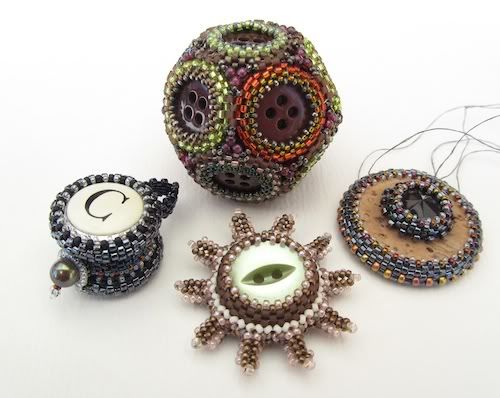

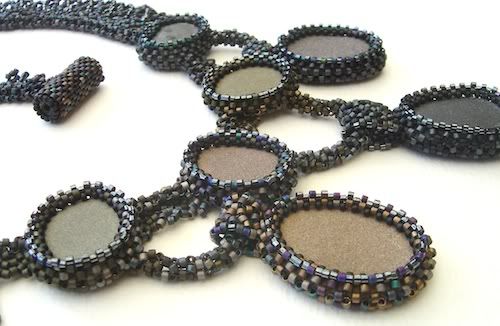
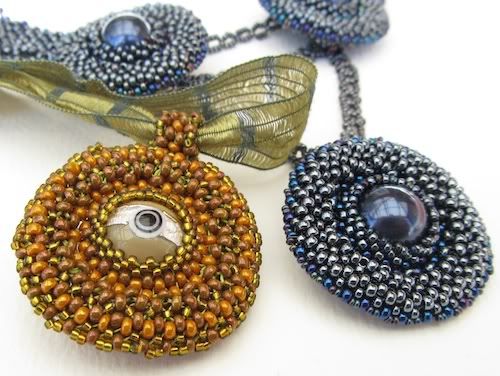
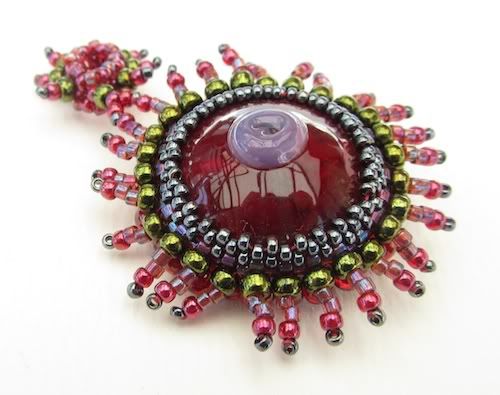


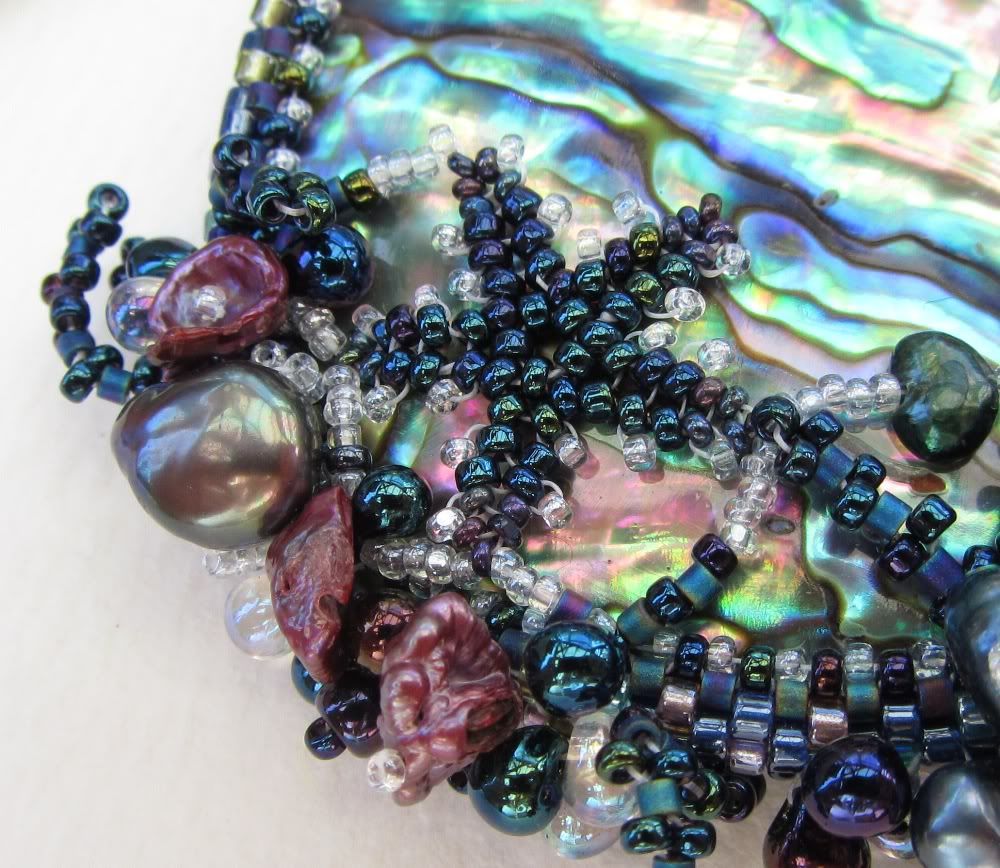
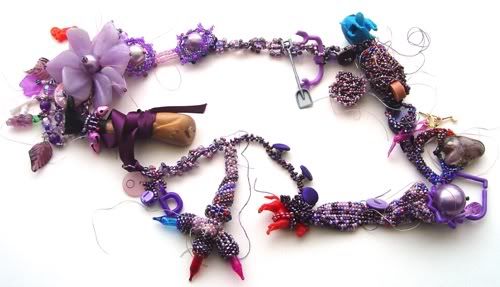








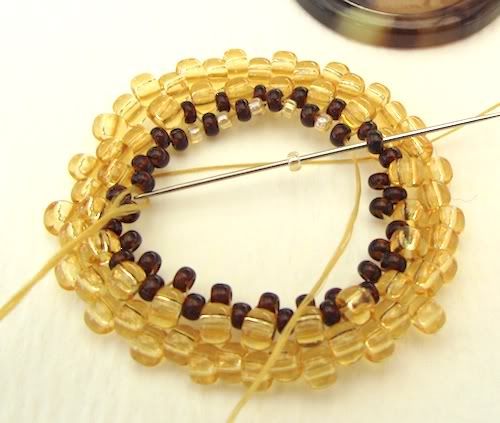
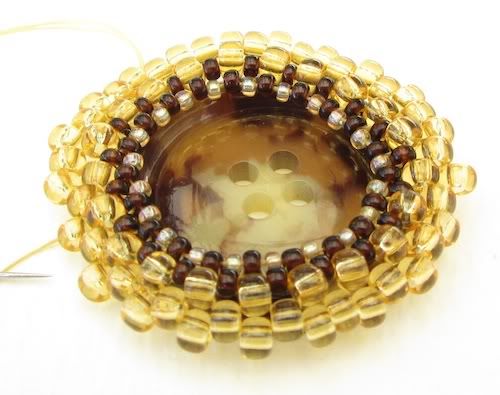

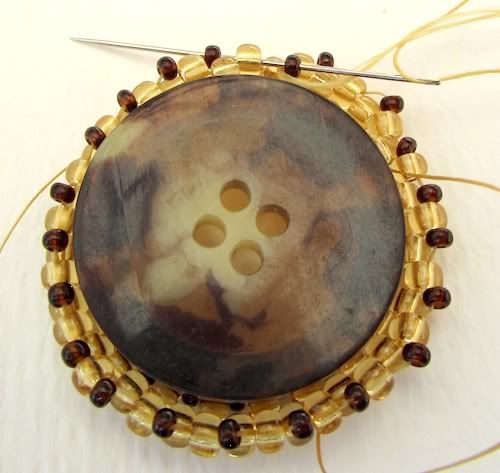
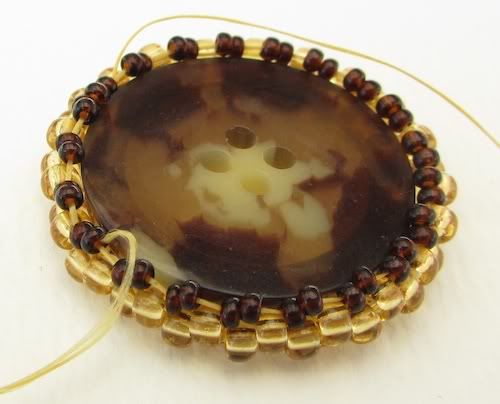
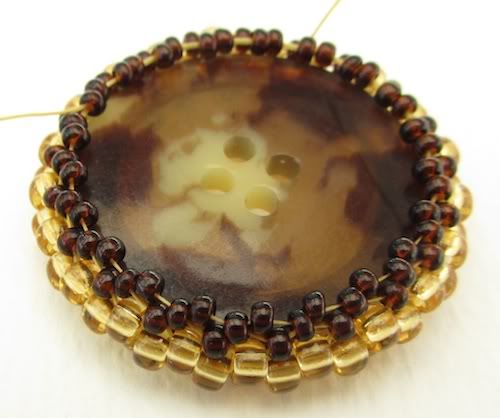
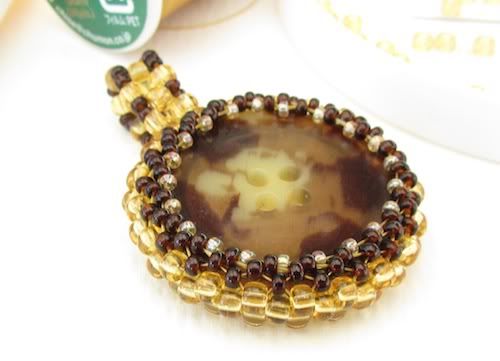
2 comments:
This is great! I have some little test cabs that I'm tempted to try this with :)
(I'm having huge trouble with the CAPTCHA trying to post this)
Fabulous Lynn!
Post a Comment